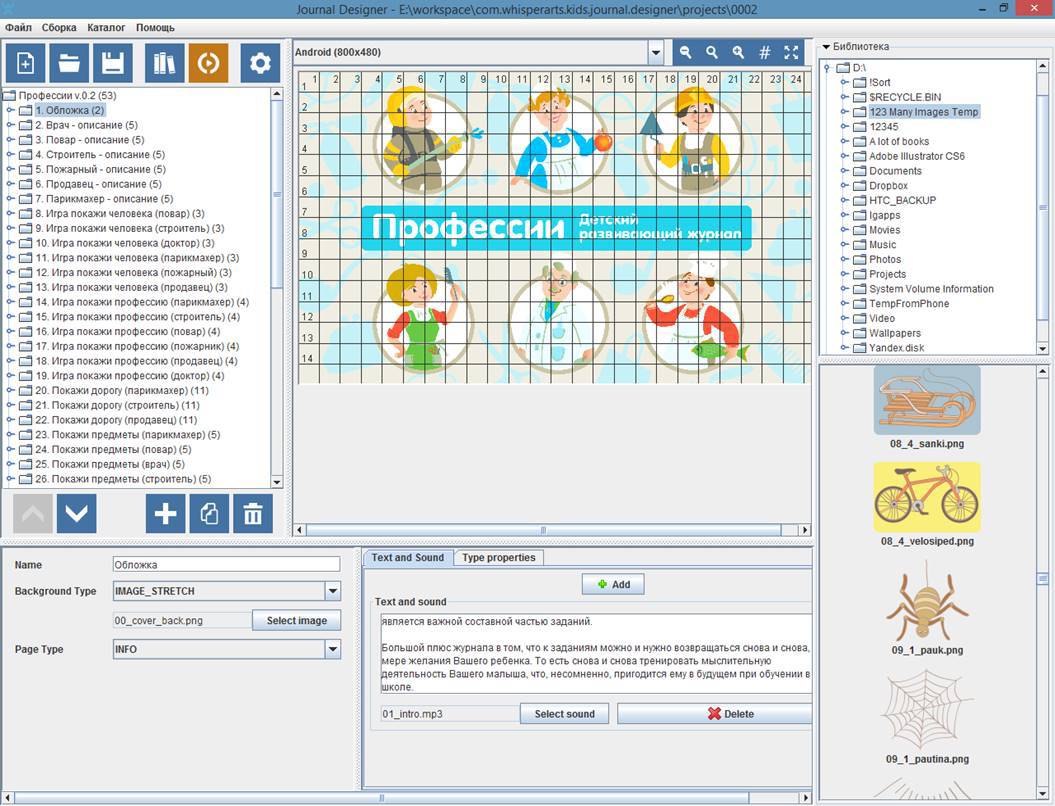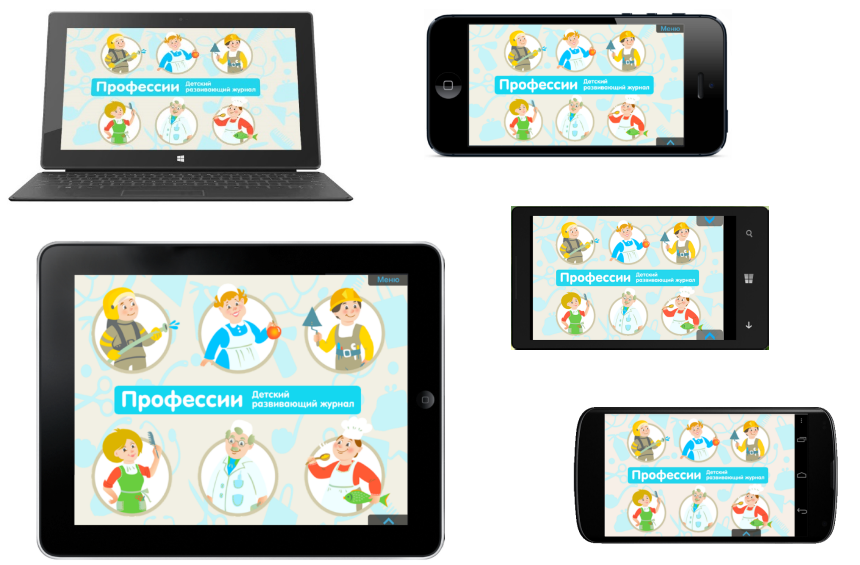How to quickly prepare cross-platform content for mobile devices (and a little about the competition Imagine Cup 2014)
Earlier in one of our articles, we talked about how we tried to defeat cross-platform and multi-screen and use not ordinary images as resources, but SVG vector images.
Our experiments did not stop there, and we decided to create something that will help us prepare cross-platform content even faster and more efficiently. And now, a year later, we want to share what we have achieved, what has happened and how it works.

')
As a result, we got not just an application, but a whole PLATFORM for creating cross-platform entertainment and educational content. Let me introduce you to WA Edugame Creator.
Interested? I ask under the cat.
All of you know paper developing magazines ("Murzilka", "Fidget", etc.). Children enjoy working with them. We saw opportunities that mobile technologies could give developing magazines. Therefore, we decided to create an application in which:
As a result, not just an application was born, but a whole PLATFORM and a series of applications created on its basis.
Our WA Edugame Creator Platform consists of:

This is approximately what our visual designer looks like with which we create content for our magazines, set up standard actions, and we can immediately see how the content will look on certain screen resolutions.

As server part we use Microsoft Azure.

As you understand, the market for devices, and therefore the zoo of screen resolutions, is simply great. We adapt the content to all popular permissions, and the content adapted to the user's screen will be downloaded to the user's devices. Viewers are native applications for each platform (Andorid, iOs, Windows Phone, Windows Store).

On the basis of our platform WA Edugame Creator running the following applications.
On the last application I want to say separately. It was launched together with our partners from the Uniline company. Uniline Company publishes cool children's magazines. One of the series - "3/9 kingdom" - with the help of our platform, we easily transferred to a mobile application.
I want to note that if you have good educational content (in paper, electronic or other form) and you do not know how to properly turn it into a good mobile application, write. We are ready to jointly make new educational applications and projects.
Approach the process of development and design is always high quality and plan what will be ahead. We spent a lot of time designing the platform, but now this time is more than paying for itself.
In this video you can get acquainted with a small fragment of the gameplay that is present in the applications.
What we did:
We hope our experience is useful. All success.
It would be great if you share your experience in developing cross-platform content in the comments.
Students work and train in our team, this allowed us to take part in the ImagineCup 2014 project. We submitted an application with the project “ Children's interactive development magazine ” and went to the regional qualifying final.
On the day of the qualifying round, we arrived at the Moscow office of Microsoft. About 20 teams took part in the selection. All projects were interesting. Some projects were strong and interesting, some - weaker.
It should be noted that many interesting projects and ideas simply failed due to the fact that the teams did not prepare for the presentation and devoted more time to finalizing the project than its presentations. Our advice to future participants: devote more time to the presentation of the project and spend a few rehearsals of your report. As Dmitry Soshnikov said, arrange shows on the stage, not reports. The jury and all viewers are awaiting the show.
We entered the top five of the finalists, and our project was separately noted by the jury, but, unfortunately, we did not reach the final itself (since only the first three had entered it).
Thank you Microsoft for the perfectly organized competition. We hope that next year one of the qualifying finals will be held in our city of Smolensk.
Sincerely, Oleg Demyanov, WebCanape Team
and the mobile development unit Whisper Arts
Our experiments did not stop there, and we decided to create something that will help us prepare cross-platform content even faster and more efficiently. And now, a year later, we want to share what we have achieved, what has happened and how it works.

')
As a result, we got not just an application, but a whole PLATFORM for creating cross-platform entertainment and educational content. Let me introduce you to WA Edugame Creator.
Interested? I ask under the cat.
Why and for what
All of you know paper developing magazines ("Murzilka", "Fidget", etc.). Children enjoy working with them. We saw opportunities that mobile technologies could give developing magazines. Therefore, we decided to create an application in which:
- there are interactive tasks
- You can return to the task again and again,
- in addition to the game component, there should be an educational part,
- application and content must be cross-platform,
- New content should be created easily and quickly.
As a result, not just an application was born, but a whole PLATFORM and a series of applications created on its basis.
Composition WA Edugame Creator
Our WA Edugame Creator Platform consists of:
- designer - visual content editor;
- server side;
- content viewer - or, more simply, an application for viewing content created on end devices.

This is approximately what our visual designer looks like with which we create content for our magazines, set up standard actions, and we can immediately see how the content will look on certain screen resolutions.

As server part we use Microsoft Azure.

As you understand, the market for devices, and therefore the zoo of screen resolutions, is simply great. We adapt the content to all popular permissions, and the content adapted to the user's screen will be downloaded to the user's devices. Viewers are native applications for each platform (Andorid, iOs, Windows Phone, Windows Store).

On the basis of our platform WA Edugame Creator running the following applications.
On the last application I want to say separately. It was launched together with our partners from the Uniline company. Uniline Company publishes cool children's magazines. One of the series - "3/9 kingdom" - with the help of our platform, we easily transferred to a mobile application.
I want to note that if you have good educational content (in paper, electronic or other form) and you do not know how to properly turn it into a good mobile application, write. We are ready to jointly make new educational applications and projects.
findings
Approach the process of development and design is always high quality and plan what will be ahead. We spent a lot of time designing the platform, but now this time is more than paying for itself.
In this video you can get acquainted with a small fragment of the gameplay that is present in the applications.
What we did:
- Created a universal platform for the preparation of educational content.
- The preparation of journals and their release occur without the participation of programmers.
- Content has become cross-platform and multi-screen.
- New issues of magazines and fairy tales come out on all platforms simultaneously.
- Updating content is quick and easy.
- Thousands of satisfied users, children and parents!
We hope our experience is useful. All success.
It would be great if you share your experience in developing cross-platform content in the comments.
PS: What about Imagine Cup 2014?
Students work and train in our team, this allowed us to take part in the ImagineCup 2014 project. We submitted an application with the project “ Children's interactive development magazine ” and went to the regional qualifying final.
On the day of the qualifying round, we arrived at the Moscow office of Microsoft. About 20 teams took part in the selection. All projects were interesting. Some projects were strong and interesting, some - weaker.
It should be noted that many interesting projects and ideas simply failed due to the fact that the teams did not prepare for the presentation and devoted more time to finalizing the project than its presentations. Our advice to future participants: devote more time to the presentation of the project and spend a few rehearsals of your report. As Dmitry Soshnikov said, arrange shows on the stage, not reports. The jury and all viewers are awaiting the show.
We entered the top five of the finalists, and our project was separately noted by the jury, but, unfortunately, we did not reach the final itself (since only the first three had entered it).
Thank you Microsoft for the perfectly organized competition. We hope that next year one of the qualifying finals will be held in our city of Smolensk.
Sincerely, Oleg Demyanov, WebCanape Team
and the mobile development unit Whisper Arts
Source: https://habr.com/ru/post/222495/
All Articles